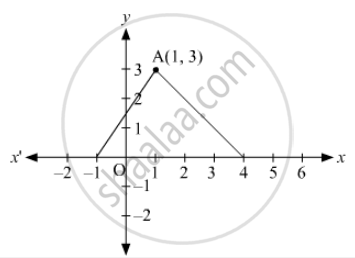Advertisements
Advertisements
Question
If R (x, y) is a point on the line segment joining the points P (a, b) and Q (b, a), then prove that x + y = a + b.
Solution
The formula for the area ‘A’ encompassed by three points ( x1 , y1) , (x2 , y2) and (x3 , y3) is given by the formula,
\[∆ = \frac{1}{2}\left| \left( x_1 y_2 + x_2 y_3 + x_3 y_1 \right) - \left( x_2 y_1 + x_3 y_2 + x_1 y_3 \right) \right|\]
If three points are collinear the area encompassed by them is equal to 0.
It is said that the point R(x, y) lies on the line segment joining the points P(a, b) and Q(b, a). Hence we understand that these three points are collinear. So the area enclosed by them should be 0.
\[∆ = \frac{1}{2}\left| \left( ay + xa + b^2 \right) - \left( xb + by + a^2 \right) \right|\]
\[ 0 = \frac{1}{2}\left| ay + xa + b^2 - xb - by - a^2 \right|\]
\[ 0 = ay + xa + b^2 - xb - by - a^2 \]
\[ a^2 - b^2 = ax + ay - bx - by\]
\[ \left( a + b \right)\left( a - b \right) = \left( a - b \right)\left( x + y \right)\]
\[ \left( a + b \right) = \left( x + y \right)\]
Hence under the given conditions we have proved that x + y = a + b .
APPEARS IN
RELATED QUESTIONS
Prove that the points (3, -2), (4, 0), (6, -3) and (5, -5) are the vertices of a parallelogram.
If A and B are (1, 4) and (5, 2) respectively, find the coordinates of P when AP/BP = 3/4.
Determine the ratio in which the point P (m, 6) divides the join of A(-4, 3) and B(2, 8). Also, find the value of m.
The line joining the points (2, 1) and (5, -8) is trisected at the points P and Q. If point P lies on the line 2x - y + k = 0. Find the value of k.
If the point `P (1/2,y)` lies on the line segment joining the points A(3, -5) and B(-7, 9) then find the ratio in which P divides AB. Also, find the value of y.
Prove that the diagonals of a rectangle ABCD with vertices A(2,-1), B(5,-1) C(5,6) and D(2,6) are equal and bisect each other
If (x, y) be on the line joining the two points (1, −3) and (−4, 2) , prove that x + y + 2= 0.
If the point P (m, 3) lies on the line segment joining the points \[A\left( - \frac{2}{5}, 6 \right)\] and B (2, 8), find the value of m.
Find the value of a for which the area of the triangle formed by the points A(a, 2a), B(−2, 6) and C(3, 1) is 10 square units.
What is the area of the triangle formed by the points O (0, 0), A (6, 0) and B (0, 4)?
Two vertices of a triangle have coordinates (−8, 7) and (9, 4) . If the centroid of the triangle is at the origin, what are the coordinates of the third vertex?
Find the values of x for which the distance between the point P(2, −3), and Q (x, 5) is 10.
If the points A (1,2) , O (0,0) and C (a,b) are collinear , then find a : b.
The distance of the point (4, 7) from the x-axis is
In Fig. 14.46, the area of ΔABC (in square units) is

The line segment joining the points A(2, 1) and B (5, - 8) is trisected at the points P and Q such that P is nearer to A. If P also lies on the line given by 2x - y + k= 0 find the value of k.
If segment AB is parallel Y-axis and coordinates of A are (1, 3), then the coordinates of B are ______
The line segment joining the points (3, -1) and (-6, 5) is trisected. The coordinates of point of trisection are ______.
Point (–3, 5) lies in the ______.
If the points P(1, 2), Q(0, 0) and R(x, y) are collinear, then find the relation between x and y.
Given points are P(1, 2), Q(0, 0) and R(x, y).
The given points are collinear, so the area of the triangle formed by them is `square`.
∴ `1/2 |x_1(y_2 - y_3) + x_2(y_3 - y_1) + x_3(y_1 - y_2)| = square`
`1/2 |1(square) + 0(square) + x(square)| = square`
`square + square + square` = 0
`square + square` = 0
`square = square`
Hence, the relation between x and y is `square`.
